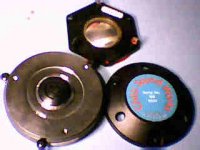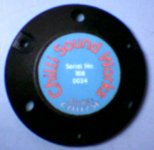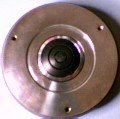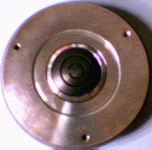CLS said:Hi ScottG,
Does that mean, we may probably get a better sound (in a particular horn and frequency band) by enlarging the back chamber ? -- Say, in a mid horn, for the sake of this topic "Large midrange... "
A large back chamber.... hmm.... so how about a very very big one -- just leave it open? I've tried 'open back' on my Oris horn -- no back chamber. I did like the sound better than the one with chamber -- sounded more open and free, less coloration of resonance. And so did Mr. Bruce Edgar suggest in his article of Tractrix midhorn.
So how about removing the back chamber (rear cover) of a compression driver? I haven't seen this.
CLS🙂
Though not exactly related to wht you are discussing here - some time back there was a discussion about impacts form the back chamber that I summed up here:
http://members.aon.at/kinotechnik/diyaudio/diy_audio/BDMD/Introducing_BDMD.htm
Might be it fits one way or another
🙂
Michael
Paul W said:The consumer versions of the JBL Be drivers also implement a larger rear chamber than the equivalent pro versions.
Depending on specific compression driver construction, it may be possible to space the rear chamber/cup further back with circular rings cut from aluminum, masonite, MDF, etc.
The system I'm working on now includes Infinite Baffle midbass to go along with IB subs...bigger boxes can be better boxes!
Yeah, there is nothing that says you must have fb at a certain upper freq. for home use with a proper horn/waveguide. It will of course lower the amplitude/eff. of its lower freq. response, but it should also extend that response - offering basically a more "tilted-up" freq. response than normal but with increased extension.
In fact with various "CD" waveguides and their attending "downward tilt" in freq. response, I think its possible to "tailor" a specific "CD" waveguide to a modified compression driver with a substantially lowered fb - achieving something closer to a flat response. Just a guess though.
After looking at the impedance trace of varying compression drivers I'd also think that certain techniques could be used to flatten and "smooth-out" the resonance/impedance trace at fb, especially with increased enclosure volume. I don't think there is any reason for Radian's impedance to be as "sloppy" as it is. In this particular area I think some of the pricier tweeters are considerably more advanced (..particularly something like the air-circ from ScanSpeak).
The price for such a modification will obviously be increased distortion.. but then again, it may be largely irrelevant for most users for average domestic use.
IB midbass - sounds interesting! (..also sounds like it might achieve some "domestic harmony".) 😀
CLS said:Hi ScottG,
Does that mean, we may probably get a better sound (in a particular horn and frequency band) by enlarging the back chamber ? -- Say, in a mid horn, for the sake of this topic "Large midrange... "
If we manage to loosen the suspension of a given driver (higher compliance), with the same motor and cone mass, the fs drops and the Qts also drops. A lower Q driver drivers the horn better, so it makes sense.
A large back chamber.... hmm.... so how about a very very big one -- just leave it open? I've tried 'open back' on my Oris horn -- no back chamber. I did like the sound better than the one with chamber -- sounded more open and free, less coloration of resonance. And so did Mr. Bruce Edgar suggest in his article of Tractrix midhorn.
So how about removing the back chamber (rear cover) of a compression driver? I haven't seen this.
CLS🙂
Enlarging the back-chamber for a standard compression driver - even a 1" exit version.
A LOT can be done here - see the advancements on the Scan Speak air-circ and recent revelator tweeters. Less filler material (like wool or poly fiber) and far more purposeful routing of the out-of-phase portion.
A lower Q *can* drive a waveguide better, but it's really up to the modified driver and the waveguide's "gain" character.
You can of course alternatively go with "open-back" (dipole), but you may end-up with some response irregularities - particularly if its a small horn/waveguide. Speaking of..:
I believe that Bastanis loudspeakers utilize open-back compression drivers for their small super tweeter/waveguide - but more purposefully to achieve greater overall dispersion character and a resulting "airy" sound.
Good to know about the success with the Oris's - those use BMS coaxials correct? If so that means that even these drivers (radial) can benefit from modification.
Lots of different things to try here. 🙂
No, my Oris is the "original" big throat version (for Lowther/AER).
I had tried PM4 for a short period and eventually stayed with a Focal 7" mid. Both sound better without back chamber.
And thanks for the info of Bastanis, I'll look into it. 🙂
I had tried PM4 for a short period and eventually stayed with a Focal 7" mid. Both sound better without back chamber.
And thanks for the info of Bastanis, I'll look into it. 🙂
CLS said:No, my Oris is the "original" big throat version (for Lowther/AER).
I had tried PM4 for a short period and eventually stayed with a Focal 7" mid. Both sound better without back chamber.
And thanks for the info of Bastanis, I'll look into it. 🙂
Ah. My bad.

I should also note that "open back" is probably the place to *start* with modifications on compression drivers. In other words the driver's suspension and mms will help to describe its lower freq. limitations (fs) in a generalized sense. That should give a starting point for modifications and potentially more appropriate horns/waveguides.
An aperiodic venting system could lower the rising impedance at fb and lower non-linear distortion as a result. I think several compression drivers could benefit from this alone. Particularly drivers with more compliant surrounds like the DE250.
I saw some cut-away view of BMS driver. Their 'back-chamber' seem difficult (or impossible) to modify. The ring diaphragm fires towards the rear and the wave is guided by the passages back to front. So their 'back' chambers are actually in 'front' of the driver and very small in volume (or nearly non-existent in the smaller one). In such case, we got no chance🙁
Correct me if I'm wrong.
Correct me if I'm wrong.
I've heard the Bastanis open back CD tweeter. It seemed to work well.
Have also run my Altec 806A drivers open back. Seems to make little or no difference. Gotta try it next with the Radians.
Have also run my Altec 806A drivers open back. Seems to make little or no difference. Gotta try it next with the Radians.
panomaniac said:...
Have also run my Altec 806A drivers open back. Seems to make little or no difference. ....
Interesting.
Maybe the compression in front (by phase plug and throat) gives a very big load on the dome already and overwhelms the influence of back chamber?
Yes, I suppose that could be. It was a surprise to me. So much so, that I doubt myself
I'll have to run FR and impedance charts again someday. But there wasn't much difference to the ear.
I'll have to run FR and impedance charts again someday. But there wasn't much difference to the ear.
Modified 1" exit Radian 465
Hi All,
I'm unfortunately no David Bailey and my webcam certainly isn't in his league, but here's some jpg's of the above mentioned.
I will post some SPL curves later this week when I get them measured with my freshly refurbished HP35665A DSA - Dynamic Signal Analyser, using a B&K 4133 mic on B&K 2606 pre Amp.
Please observe the label at the back cap represents this as a integrated device part on a proprietary Horn flare of a Pro Audio loudspeaker product offering from CSW - Chilli Sound Works.
I work at this company as an effort to try and earn a keeping and hope it will be OK to ask to please keep this in mind.
Best regards
a1greatdane
Hi All,
I'm unfortunately no David Bailey and my webcam certainly isn't in his league, but here's some jpg's of the above mentioned.
I will post some SPL curves later this week when I get them measured with my freshly refurbished HP35665A DSA - Dynamic Signal Analyser, using a B&K 4133 mic on B&K 2606 pre Amp.
Please observe the label at the back cap represents this as a integrated device part on a proprietary Horn flare of a Pro Audio loudspeaker product offering from CSW - Chilli Sound Works.
I work at this company as an effort to try and earn a keeping and hope it will be OK to ask to please keep this in mind.
Best regards
a1greatdane
Attachments
1" exit Radian 465 structure close up with 3 slit phase plug
and finally close up of structure with 3 concentric slit plug...
Took some effort to get this compressed down to uploadable format...
Hope this will be good food for thought and will get on to the measures next.
a1greatdane
and finally close up of structure with 3 concentric slit plug...
Took some effort to get this compressed down to uploadable format...
Hope this will be good food for thought and will get on to the measures next.
a1greatdane
Attachments
Re: Radian 465 mod
Hi panomaniac,
quite impressively quick response on that keyboard over there...
I will get measures done soon as.
Hope i can manage to squeeze them inside that 100k upload limit...
Any preferred format? But take it .pdf will do for starters?
Could upload an ASCii .txt file with the actual measurement.
Cheers
a1greatdane
Hi panomaniac,
quite impressively quick response on that keyboard over there...
I will get measures done soon as.
Hope i can manage to squeeze them inside that 100k upload limit...
Any preferred format? But take it .pdf will do for starters?
Could upload an ASCii .txt file with the actual measurement.
Cheers
a1greatdane
I'd suggest upload your photos onto some free spaces and then link to the forum. In this way you'll have no limit in size.
If you can simply save the graphs in GIF or PNG format they will be just right to post here. If you don't know how to do that, we can help!
(don't use jpg, bmp or PDF)
(don't use jpg, bmp or PDF)
- Status
- Not open for further replies.
- Home
- Loudspeakers
- Multi-Way
- Large midrange for OB??? Scott G ?



